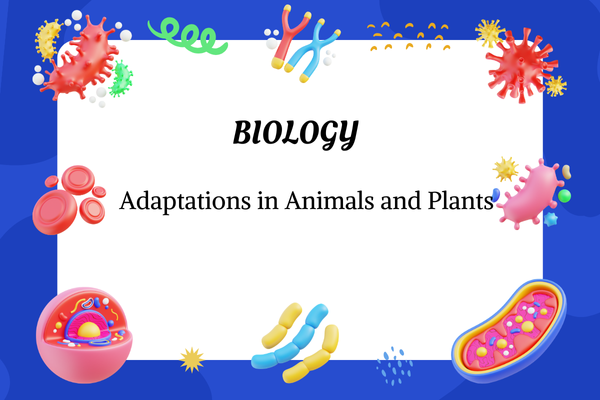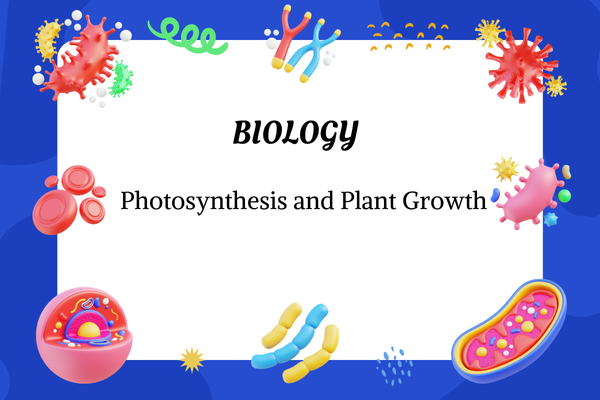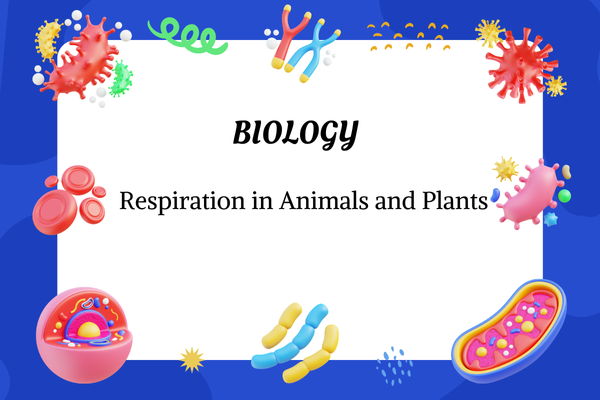Introduction – Nature’s Amazing Survival Toolbox
Imagine living in a desert where it’s super hot , or in icy Antarctica. Could you survive there? Probably not without special clothes or gear. But animals and plants do survive in extreme places—all thanks to adaptations!
Adaptations are like superpowers that help living things survive in their environment. Some help them stay warm, others help them find food or avoid predators. Whether it’s a cactus in the desert or a polar bear in the snow, adaptations make life possible in every corner of Earth.
expert-led Biology classes – visit our website to learn more
Who Adapts, and How?
Every living thing—plants, animals, even tiny microbes—adapts to where it lives. And not just once! Over many generations, their bodies and behaviors slowly change to suit their surroundings.
- Animals may develop thick fur to survive cold temperatures, long legs to run faster and escape predators, sharp teeth for catching and tearing food, or camouflage to hide from enemies or sneak up on prey. These changes are not magic—they’re slow improvements passed from parents to babies.
- Plants might grow big roots to reach deep water underground, waxy leaves to hold in moisture, or even develop poisons or spines to protect themselves from hungry animals. Each of these changes helps the plant live longer and grow better in its habitat.
- These changes don’t happen overnight—they take thousands of years and are passed down through a process called evolution. Over time, only the best traits stick around!
Why Do Living Things Need Adaptations?
Nature isn’t easy. There’s heat, cold, predators, floods, droughts—and only the well-adapted survive. That’s why adaptations are essential.
- Animals and plants need to protect themselves from harsh weather like extreme heat, freezing cold, or dry conditions.
- They must be able to find or catch food, whether it’s through hunting, climbing, or growing tall to reach sunlight.
- Escaping from enemies is another challenge—many animals have developed ways to hide, run, or defend themselves.
- Reproduction and raising young is critical for species survival—some animals build nests or care for their babies, while others lay thousands of eggs.
- And for plants, adaptations help them survive in poor soil, low light, or crowded forests.
All these challenges mean that only creatures with the right tools—adaptations—can survive and pass on their traits.
When Do Adaptations Develop?
Not quickly! Adaptations take a very long time to appear—often hundreds or millions of years. It’s a slow and natural process. When a trait helps a living thing survive better in its environment, it has a greater chance of living long enough to have babies. Then, it passes that helpful trait on.
- For example, a snake that blends into dry leaves might avoid predators better than one that doesn’t. Over time, more snakes are born with that helpful coloring.
- Similarly, a flower that smells sweet and has bright petals may attract more insects for pollination. That means more seeds, more plants, and more flowers like it in the future.
Little changes add up across generations, shaping how species look and behave.
Where Can We See Adaptations?
Everywhere! From deep oceans to high mountaintops, animals and plants show amazing adaptations suited to their environments.
- In deserts, camels store fat in their humps to survive without food or water for days. Cacti have no leaves, just spines, to stop water loss and protect themselves.
- In freezing polar regions, penguins have layers of fat (blubber) and waterproof feathers, while arctic plants grow low to the ground to avoid icy winds.
- In dense rainforests, monkeys have strong, grippy tails to swing from tree to tree. Rainforest plants often have large leaves and special “drip tips” to get rid of extra water.
- Underwater, fish use gills to breathe, and seaweed clings tightly to rocks so it doesn’t get washed away by waves.
Every environment shapes its living things in a unique way.
How Do Adaptations Work? (Types of Adaptations)
Adaptations come in different forms, and they usually fall into three main types:
1. Structural Adaptations – These are body parts or features that help the organism survive.
For example: A lion’s sharp teeth help it tear meat, and a cactus’s thick stem stores water.
2. Behavioral Adaptations – These are things animals do (instincts or learned behaviors) to survive.
For example: Birds flying to warmer places in winter (migration), or bears sleeping through the cold months (hibernation).
3. Physiological Adaptations – These are internal body functions or processes.
For example: Snakes produce venom to catch and digest prey. Camels can conserve water in their bodies and go for days without drinking.
Most living things use a mix of these to adapt to their surroundings and survive the challenges of life.
Core Concepts – What You Should Know
| Concept | Meaning | Example |
| Adaptation | A special trait that helps an organism survive | Polar bear’s white fur |
| Structural Adaptation | A physical part of the body | Webbed feet in ducks |
| Behavioral Adaptation | A learned or instinctive action | Birds flying south for winter |
| Physiological Adaptation | A body function or chemical ability | Snake’s venom or camel’s water storage |
| Evolution | Slow change in a species over time | Giraffes developing longer necks |
These are the building blocks of how life changes and thrives in every kind of environment.
FAQs – Curious Questions Kids Might Ask
Q1: Can animals choose to adapt?
Nope! Adaptations happen slowly through evolution—animals can’t just decide to grow longer legs!
Q2: Do humans have adaptations?
Yes! Our opposable thumbs, upright walking, and smart brains are all adaptations that help us survive and solve problems.
Q3: Can a plant move to adapt?
No, but it might grow differently over time. For example, plants in dark places may grow taller to reach light.
Q4: Why do animals camouflage?
To hide from predators or sneak up on prey—camouflage is a clever trick for survival!
Q5: Are all adaptations helpful?
Most are—but if the environment changes too quickly, some adaptations might not be helpful anymore. That’s when species may struggle to survive.
Fun Facts About Adaptations!
- Chameleons don’t just change color to hide—they also do it to show how they feel or to regulate their body temperature!
- Cacti have spines instead of leaves to stop animals from eating them and to reduce water loss.
- Penguins may not fly through the air, but their flippers are perfect for swimming underwater like little rockets.
- Kangaroos can’t walk backward! Their strong tails help them balance as they hop across the land.
- Octopuses are the masters of disguise—they can change their color, shape, and even skin texture to match rocks or coral!
Conclusion – The Art of Staying Alive
Adaptations are nature’s way of saying “be prepared.” Whether it’s hot, cold, wet, or wild, every living thing has clever ways to survive and thrive. From sharp claws to sticky tongues, from deep roots to floating seeds, adaptations show us just how amazing life can be.
So next time you see a cactus, a polar bear, or even your pet, look closely—you’re looking at millions of years of survival skills in action!








